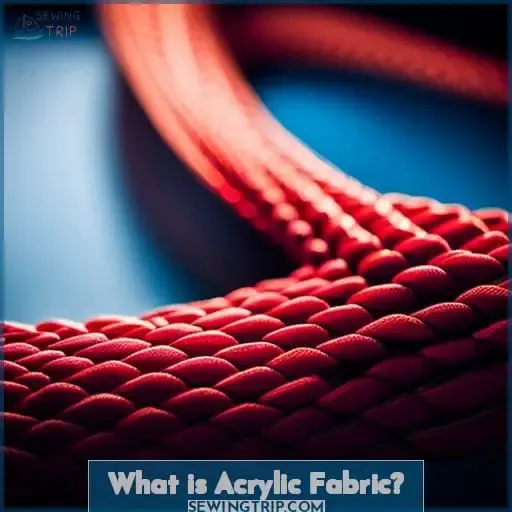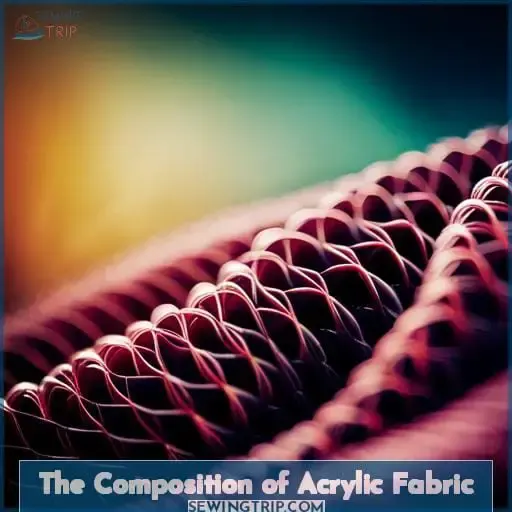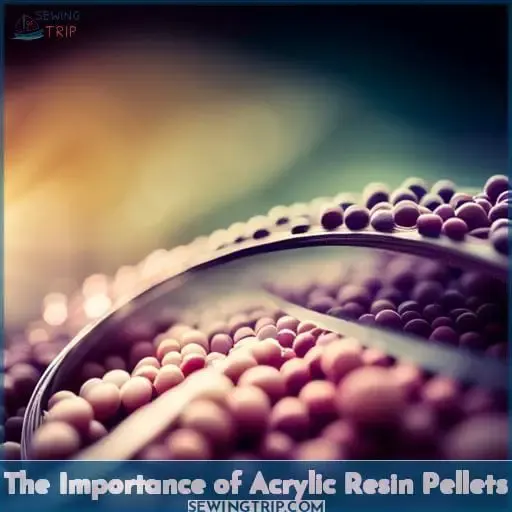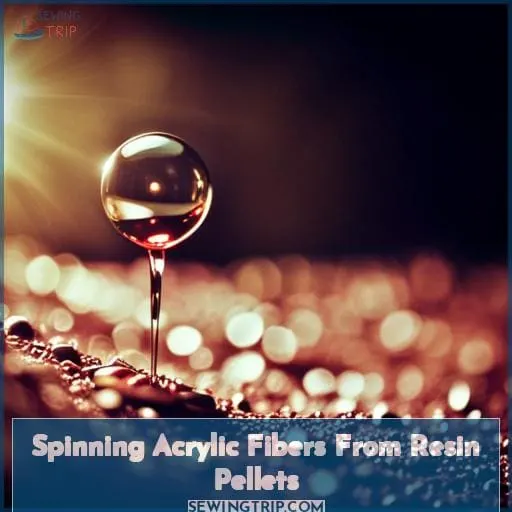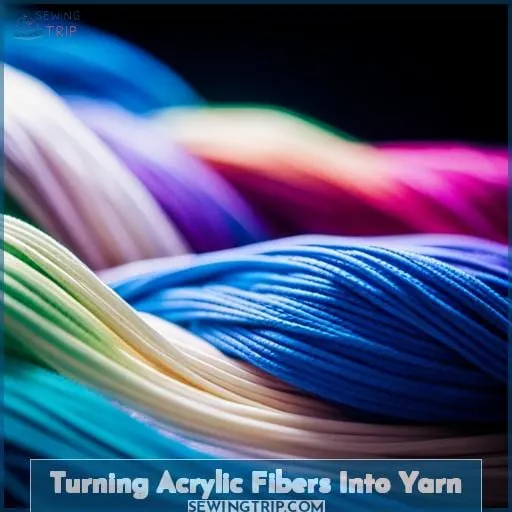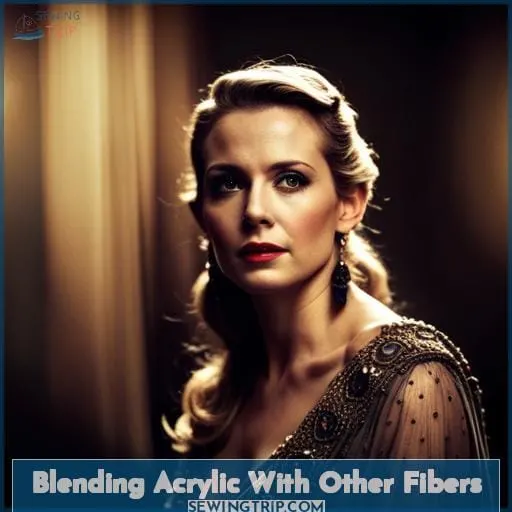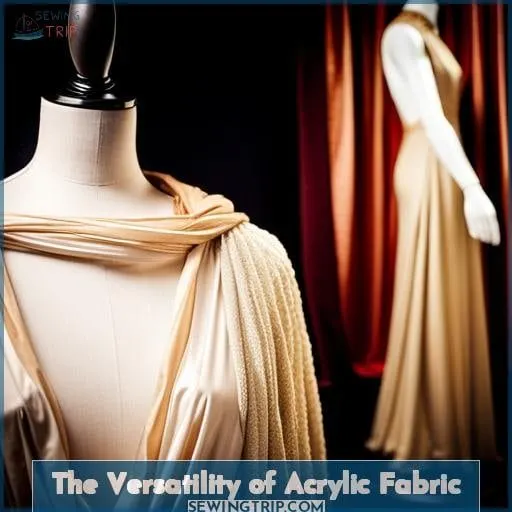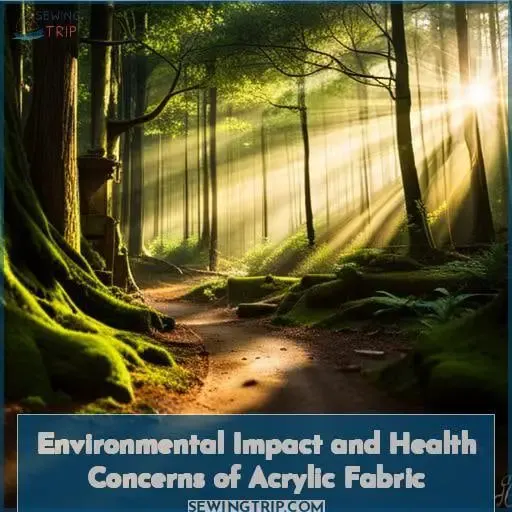This site is supported by our readers. We may earn a commission, at no cost to you, if you purchase through links.
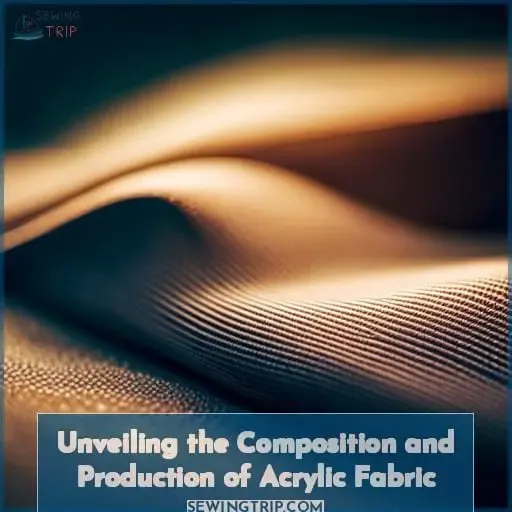 As the weather gets colder, few things are more comforting than slipping on a warm sweater made of acrylic fabric.
As the weather gets colder, few things are more comforting than slipping on a warm sweater made of acrylic fabric.
Acrylic fabric is an affordable version of wool, containing a higher percentage of acrylonitrile monomers than other synthetic materials. It’s often used to make clothing items such as sweaters and socks due to its pleasant texture and lightweight warmth.
In this article, you’ll uncover exactly what goes into making acrylic fabric—from its composition to the production process—as well as learn all about its versatility and environmental impact.
So if you’re curious about how one type of man-made polymer fiber becomes something we can wear every day, read on to find out more!
Table Of Contents
- Key Takeaways
- What is Acrylic Fabric?
- The Composition of Acrylic Fabric
- The Role of Acrylonitrile in Acrylic Fabric Production
- The Process of Making Acrylic Fabric
- The Importance of Acrylic Resin Pellets
- Spinning Acrylic Fibers From Resin Pellets
- Turning Acrylic Fibers Into Yarn
- Blending Acrylic With Other Fibers
- The Versatility of Acrylic Fabric
- Environmental Impact and Health Concerns of Acrylic Fabric
- Conclusion
Key Takeaways
- Acrylic fabric is derived from acrylonitrile, a petroleum-based compound.
- It is made from petrochemicals such as oil and coal.
- The primary component of acrylic fabric is polyacrylonitrile, which is transformed from petroleum and natural gas.
- Spinnerets are used in the creation of acrylic threads.
What is Acrylic Fabric?
You’ve got that cozy sweater on, but don’t be fooled – it’s just plastic from the ground. Acrylic fabric, that snuggly sweater keeping you warm, is a synthetic fiber made from acrylonitrile, a petroleum-based compound.
Through a process called polymerization, acrylonitrile molecules bind together into long chains creating a plastic-like solution that’s pushed through spinnerets to form threads.
Though durable and wrinkle-resistant, acrylic fabric lacks breathability. It’s also prone to pilling and stains, so handle with care! Blending acrylic with natural fibers helps soften its plastic feel.
While cozy for lounging, this synthetic fabric comes with environmental costs. But armed with knowledge, you can make conscious choices about acrylic’s place in your wardrobe.
The Composition of Acrylic Fabric
Believe it or not, acrylic fabric is actually made from plastic! Those cozy sweaters are derived from petrochemicals like oil and coal. So acrylic clothing starts its life deep underground before becoming the textile we know today.
Through a chemical process, the building blocks of acrylic fibers are formed from a plastic polymer called polyacrylonitrile. This synthetic material is extruded through spinnerets to create the endless acrylic threads that will be spun into yarn and woven.
The plastic-based fibers allow acrylic fabric to retain heat well, which is why it’s favored for sweaters and athletic wear. Of course, the composition raises concerns about sustainability and the environment.
Yet acrylic continues to be blended with natural fibers due to its durability, versatility, and reasonable cost.
The Role of Acrylonitrile in Acrylic Fabric Production
Of course, acrylic fabric owes its name and composition to acrylonitrile, that tricky synthetic chemical distilled from those infamous fossil fuels. The production process begins by transforming petroleum and natural gas into acrylonitrile through polymerization.
This chemical process enables individual acrylonitrile molecules to bond into long, repeating chains called polymers.
These acrylonitrile polymers can then be spun into acrylic fibers and woven into the versatile, durable fabric we know so well. Yet acrylic’s practicality masks its problematic petrochemical origins. Without acrylonitrile, a manmade polymer derived from finite resources, there would be no acrylic fabric.
Our modern textiles remain deeply rooted in unsustainable practices, a legacy we continue with each yard produced. Moving forward requires grappling with tough truths about the hidden costs of synthetic fabrics.
The Process of Making Acrylic Fabric
You wear acrylic fabric every day without realizing it. The production process starts with raw materials from petroleum that get processed into acrylic resin pellets. These pellets melt and extrude through spinnerets to form long acrylic fibers. The fibers then spin together to create yarn, giving acrylic fabric its plastic, synthetic feel.
Unlike natural fibers, acrylic’s completely man-made, using chemicals and industrial processes to transform petrochemicals into wearable textiles. The viscous acrylic solution hardens when it hits air, making strong yet flexible plastic threads.
While incredibly useful for its durability and versatility, acrylic fabric remains controversial due to its environmental impact and non-biodegradable components. Yet acrylic keeps appearing in clothing and textiles worldwide thanks to its unique properties and production methods involving spinneret extrusion of acrylic resin.
The Importance of Acrylic Resin Pellets
After acrylonitrile polymerizes into plastic form, the crucial acrylic resin pellets let manufacturers spin those petrochemicals into the fibers comprising your sweatshirt. The benefits of acrylic resin pellets that are made from petroleum derivatives allow textile companies immense design flexibility.
Those little plastic nuggets streamline the process of synthesizing acrylic threads with customized properties.
Their cheap, efficient production fuels fast fashion’s questionable sustainability though. Resin pellets enable creating yarns with acrylic’s signature ruggedness or uncanny softness. Blending them with natural fibers yields fabrics comfortably mimicking cotton. However, excess pre-consumer plastic from manufacturing acrylic fibers using petrochemical inputs threatens wildlife when reaching waterways.
While acrylic ultimately relies on problematic fossil fuels, resin pellets affordably supply diverse textiles.
Spinning Acrylic Fibers From Resin Pellets
- Strong yet lightweight fibers result from the extrusion process, ideal for fashion and performance fabrics.
- Fiber thickness, shape, and molecular alignment determine the tactile qualities and fiber performance.
- Textile innovators experiment with fiber combinations, improving fabric functionality.
- Careful temperature and tension controls produce the desired fiber characteristics.
- This renewable polymer-based textile contributes to progress in the field.
You’re cleverly maneuvering the acrylic into continuous filaments after polymerization. The production process transforms tiny pellets into useful acrylic fibers for modern textiles. With attention to detail, you craft soft yet durable threads, ready to be spun into inventive fabrics.
Your expertise makes the creation of acrylic textiles that both perform and delight possible.
Turning Acrylic Fibers Into Yarn
Previously we discussed how acrylic fibers are created by extruding resin pellets through spinnerets.
The acrylic fibers produced from the spinnerets are very thin and delicate on their own, like individual hairs. To make them usable for weaving fabric, the fibers need to be twisted together into a thicker, stronger yarn.
This is done by gathering many fibers together and spinning them, which twists the fibers around each other.
This yarn production process aligns with other synthetic fabrics like polyester that also start as thin extruded fibers from fossil fuel-based chemicals. Transforming those fibers into sturdy yarn is an essential intermediate step before the final woven or knitted acrylic fabric can be created.
Understanding this transition helps explain how thin plastic-based fibers become the acrylic textiles used in clothing, upholstery, and other end products.
Blending Acrylic With Other Fibers
Wonder weaving wool with wavy water-repellent acrylic adds affordable allure. Blending techniques artfully unite natural fibers like wool with synthetics including acrylic. Complementary fiber combinations capitalize on unique benefits – wool’s warmth and absorbency balance acrylic’s durability and stain resistance.
However, blending challenges arise. Fibers like wool and acrylic have different physical properties affecting texture, drape and care. Testing fiber compatibility minimizes pilling, distortion and shrinkage. With thoughtful blending, fabrics gain functional fashion fusion.
Harmonizing natural with synthetic fibers creates innovative, affordable textiles meeting your adventurous style needs while gently stewarding limited resources.
The Versatility of Acrylic Fabric
Feel the coziness of acrylic sweaters and jackets in winter. Acrylic fabric’s prized for its versatility spanning clothing to furniture. It mimics natural fibers like cotton while avoiding pilling. Tap into the advantages of acrylic through stain-resistant upholstery and durable area rugs.
But beware potential health risks from exposure to carcinogens and toxic flame retardants during production. Avoid microplastics from acrylic textiles polluting waterways. Consider more eco-friendly fabrics, but don’t overlook acrylic’s benefits like heat retention and easy washing.
Seek fabrics aligning with your values. Despite concerns, acrylic remains valued for its accessibility, cost-effectiveness and everyday applications from wigs to boot linings.
Environmental Impact and Health Concerns of Acrylic Fabric
While acrylic fabric offers many benefits, its production and use have raised serious environmental and health concerns.
Acrylic’s non-biodegradable nature leads to microplastic pollution in waterways and oceans.
Its production involves carcinogenic chemicals like acrylonitrile that generate toxic byproducts and ground ozone.
There are also concerns about flame retardant residue and other toxins transferring to human skin from acrylic clothing and upholstery.
These problems confront us all. By scrutinizing acrylic production methods and seeking sustainable alternatives, we can promote environmental and human health. Our industry’s creativity gives us the power to make positive changes. What matters most is how we use our talents.
Conclusion
You have now unveiled the composition and production of acrylic fabric, a synthetic material derived from a synthetic polymer called acrylonitrile. Acrylic fabric is highly versatile and used for clothing, furniture, and even hair extensions.
It is known for its durability and heat-retaining properties. However, it has environmental and health concerns due to its non-biodegradable nature, toxic production, and possible carcinogenic risks. Understanding what acrylic fabric is made of and how it is produced is essential in making informed decisions about its use and care.

